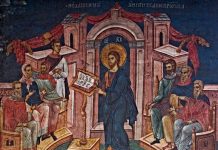I recently read a short (152 pages) and small book (each page is 5” by 6”), with beautiful font, and a fittingly short title, Chant, by Katherine le Mée, published in 1994. But don’t let its size fool you, for, in flowing and precise text, it is one of the best treatises that I have come across on Gregorian chant, the history, practice and the profound spiritual and even physiological benefits of this ancient and sacred music. Dr. Le Mée has the credentials: A Ph.D. in Romance Linguistics from Columbia, who “as a singer and conductor” has “immersed herself in the monophonic and polyphonic music of the Middle Ages”.
As the author puts it in her introduction,
Medieval people were well aware of the formative power of music. They knew that setting lines of scripture to song would imprint them ever more deeply into the memories of the worshippers, and that the words’ effects would be sustained over longer periods of time, with greater intensity. They also knew that sound is causal, that it can bring about changes in the very nature and fabric of society as well as within the individual.
What follows in the subsequent pages is an unpacking of this truth, that the music in which we immerse ourselves, especially in Liturgy, and not least in the Holy Sacrifice of the Mass, will affect us, our souls and bodies, our culture, yes, the very course of history, for good or ill. Chant, all to the good. Modern music, well, much for the ill, especially when used for sacred purposes.
The author traces the history and development of chant, its composition and notation, how it is sung, how it heals spiritually and bodily, and the role of chant in our own world. All in easy-to-read, succinct chapters. From the chapter ‘Healing Through Chant’:
One of the most powerful ways that sound acts upon us is to draw us into itself. Some music holds our attention, allowing us, for a few moments, to merge with it completely. If we are closely attentive to the sound, we are taken into it, away from pain, sorrow agitation or confusion.
And a few pages on:
It would be difficult to think of music that is more balanced than Gregorian Chant, rising and falling like the gentle ebb and flow of the sea. Neither attracting nor repelling, it remains centered at a point of rest and stability. It does not overwhelm us with sentiment but invites us to join in the devotion it calls forth.
We can trace the origins of the Gregorian chant back to the very beginnings of the Church, and even before that in the chants used in the liturgy of Israel: The perfect harmony between melody and text, the flowing rhythm, the transcendence and sublimity. That chant is rarely heard in churches since the Second Vatican Council is a deep privation, even a tragedy – and what we’re given instead is a four-hymn liturgical sandwich, often with hymns that are not all that good to begin with, and often sung even worse. It’s also odd and ironic, for the same Council described the Church’s ancient musical tradition as a ‘treasure of inestimable value’, especially the chant:
The Church acknowledges Gregorian chant as specially suited to the Roman liturgy (ut liturgiae romanae proprium): therefore, other things being equal, it should be given pride of place (principem locum) in liturgical services.
Here, the Council is following the late, great Pope Saint Pius X, who said in his 1903 motu proprio Tra Le Sollecitudini, on the restoration of sacred music:
Gregorian Chant has always been regarded as the supreme model for sacred music, so that it is fully legitimate to lay down the following rule: the more closely a composition for church approaches in its movement, inspiration and savor the Gregorian form, the more sacred and liturgical it becomes; and the more out of harmony it is with that supreme model, the less worthy it is of the temple.
All is not lost, for, as Dr. Le Mée points out, with helpful examples, chant, at a basic level, is not that difficult to learn and put into practice, even if, like many other ‘simple’ things, such as prayer, to which chant is intimately and inextricably connected, it may take a lifetime, even an eternity, to perfect.
So, tolle, lege – pick up and read. And, better yet, tolle, canta – pick up, and sing!










